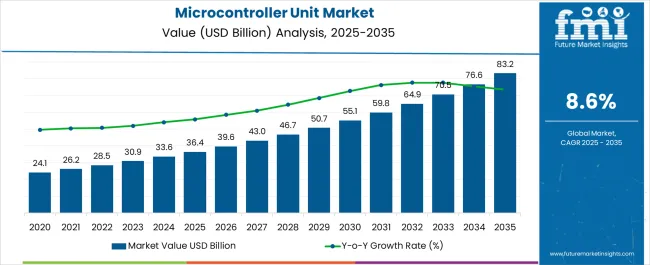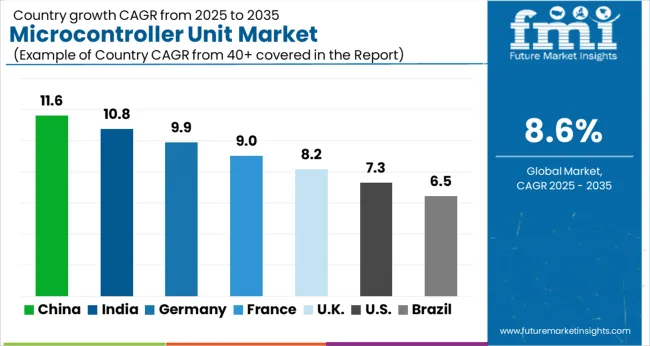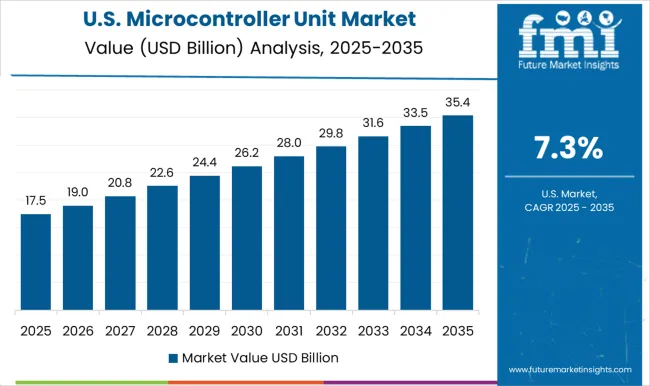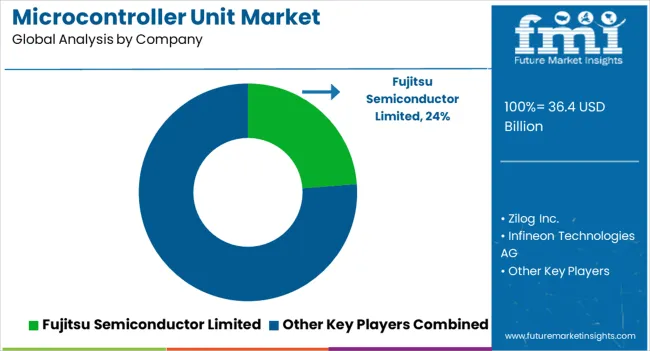The Microcontroller Unit Market is estimated to be valued at USD 36.4 billion in 2025 and is projected to reach USD 83.2 billion by 2035, registering a compound annual growth rate (CAGR) of 8.6% over the forecast period.

| Metric | Value |
|---|---|
| Microcontroller Unit Market Estimated Value in (2025 E) | USD 36.4 billion |
| Microcontroller Unit Market Forecast Value in (2035 F) | USD 83.2 billion |
| Forecast CAGR (2025 to 2035) | 8.6% |
The microcontroller unit market is expanding steadily, driven by increasing demand for automation, connected devices, and energy efficient electronics. Rising integration of microcontrollers into consumer electronics, automotive systems, and industrial automation equipment is fueling adoption across multiple industries.
The market is further supported by advancements in low power design, enhanced processing capabilities, and embedded security features, which align with the requirements of modern applications such as IoT and smart devices. The ongoing push toward electrification, particularly in vehicles and household devices, has amplified reliance on microcontrollers for performance optimization and cost effectiveness.
Regulatory frameworks promoting energy efficiency and digital transformation strategies across industries are accelerating market penetration. The overall outlook remains strong, with microcontrollers set to play a critical role in enabling smarter, faster, and more sustainable technology ecosystems.
The 32 bit product segment is expected to represent 57.60% of market revenue by 2025, making it the most dominant category. Its leadership is attributed to its superior processing power, energy efficiency, and ability to handle complex applications compared to 8 bit and 16 bit variants.
The increasing deployment of 32 bit microcontrollers in connected devices, automotive electronics, and industrial systems is driving strong adoption. Additionally, their scalability, compatibility with advanced software ecosystems, and cost effectiveness in mass production have further reinforced their growth.
As demand rises for high performance and multifunctional devices, 32 bit microcontrollers continue to dominate, supporting innovation across industries.
The consumer electronics segment is projected to account for 44.20% of total market revenue by 2025, making it the leading application area. Growth in this segment is being driven by the proliferation of smart devices, wearables, and home automation products that rely on embedded intelligence.
The ability of microcontrollers to deliver efficient power management, connectivity support, and enhanced user experiences has made them integral to product development. Consumer expectations for feature rich, responsive, and energy efficient devices are further fueling adoption.
As the consumer electronics sector continues to evolve with trends such as IoT integration and AI enabled functionalities, the demand for microcontrollers remains robust, ensuring this application segment maintains its leading position.
As per Future Market Insights (FMI), sales of microcontroller units grew at around 9.5% CAGR from 2020 to 2025. Total market valuation reached USD 36.4 billion in 2025. Between 2025 and 2035, the global market will expand at 8.6% CAGR. This will create an absolute $ opportunity of USD 83.2 billion by 2035.
Growing adoption of microcontroller units across diverse industries is a prominent factor driving the global market forward.
In medical industry, microcontrollers are widely used in medical equipment. For instance, American Hospitals Association reports that 76% of hospitals are connected with patients through smart medical device technology.
In nebulizers that are used for asthma, cystic fibrosis, in Bluetooth connected thermometers; PIC18F-Q40 microcontrollers are used. Microcontrollers made by STMicroelectronics such as STM32 series units are used in medical applications such as blood pressure monitors, digital thermometers, glucose meters, and dialysis machines.
In automobile industry, microcontrollers such as Infineon tri-core, Atmel AVR, PIC microcontroller, and Renesas microcontroller are used. Infineon tri-core 32 microcontrollers are used in gearboxes to control the injection and in combustion engine ignition. They are also used in electrical and hybrid vehicle drives.
Atmel AVR microcontrollers are used to distribute the power and flexibility for vehicles and they increase performance. Renesas microcontrollers are used in vehicles as they deliver high performance and low power consumption. These microcontrollers are used in applications such as vehicle control, power train, and driver information.
Thus, applications of microcontrollers are in varied industries and this triggers the growth of the microcontroller unit market.

| Country | United States |
|---|---|
| Projected CAGR (2025 to 2035) | 7.5% |
| Historical CAGR (2020 to 2025) | 8.0% |
| Market Value (2035) | USD 83.2 billion |
| Country | United Kingdom |
|---|---|
| Projected CAGR (2025 to 2035) | 7.8% |
| Historical CAGR (2020 to 2025) | 8.3% |
| Market Value (2035) | USD 3.6 billion |
| Country | China |
|---|---|
| Projected CAGR (2025 to 2035) | 9.6% |
| Historical CAGR (2020 to 2025) | 11.0% |
| Market Value (2035) | USD 6.1 billion |
| Country | Japan |
|---|---|
| Projected CAGR (2025 to 2035) | 8.1% |
| Historical CAGR (2020 to 2025) | 8.7% |
| Market Value (2035) | USD 5.2 billion |
| Country | South Korea |
|---|---|
| Projected CAGR (2025 to 2035) | 9.0% |
| Historical CAGR (2020 to 2025) | 10.3% |
| Market Value (2035) | USD 2.9 billion |

Rising Popularity of Electric Vehicles and Increasing Government Spending Making the USA a Dominant Market
The United States microcontroller unit market is set to reach USD 83.2 billion by 2035. Over the next ten years, the USA market will create an absolute $ opportunity of USD 24.1 billion. Microcontroller unit sales in the United States increased at a CAGR of 8.0% from 2020 to 2025. However, between 2025 and 2035, sales will exhibit a CAGR of 7.5%.
Robust growth of automotive industry is a prominent factor driving microcontroller sales in the USA. In recent years, there has been a dramatic increase in the adoption of electric vehicles across the United States. This trend is expected to further escalate over the next ten years due to rising pollution levels.
Development of autonomous vehicles with ADAS systems will elevate microcontroller unit demand across China. Sales will also surge due to rising applications in defence & military, and medical device sectors
The United States government is striving to reduce the country’s dependence on exports. For instance, in 2025, President Joe Biden signed ‘Creating Helpful Incentives to Produce Semiconductors and Science Act (CHIPS Act)’. This will allocate USD 52.7 billion in grants to the chip manufacturing companies.
The new act will create many jobs in the region, and such initiatives will trigger the microcontrollers’ market demand across the United States. Further, surging popularity of portable medical devices is likely to boost the USA market.
Rising Demand for Consumer Electronics Spurring Microcontroller Unit Sales in China
China microcontroller unit market is forecast to expand at 9.6% CAGR between 2025 and 2035. Total sales of microcontroller units in China are likely to total a valuation of USD 6.1 billion by 2035.
Microcontroller unit industry in China grew at a CAGR of 11.0% from 2020 to 2025. Between 2025 and 2035, China’s market will create an absolute $ opportunity of USD 3.7 billion.
Escalating demand for consumer electronics is driving microcontroller unit sales in China. Further, expansion of automotive sector will create growth prospects for the market.
China has become one of the leading producers and consumers of electronic devices worldwide. Factors such as high penetration of digitalization have resulted in increasing adoption of various electronic devices. This includes home appliances and smartphones. Driven by this, sales of microcontroller units are rising across China and the trend is likely to continue through 2035.
Large presence of leading microcontroller unit manufacturers is also positively impacting China market. Various companies are preferring to get microcontrollers and other electronics items from China-based companies. This is because they provide advanced solutions at lower costs.
For instance, in November 2024, Tesla, USA automobile maker, signed a joint venture with a company- Annex which is based in Jinan, China. Under the agreement, the company will deliver microcontroller chips and electronic solutions.
Consumer Electronics to Generate Maximum Revenues Through 2035
Consumer electronics segment is likely to generate most demand for microcontroller units. During the historical period, consumer electronics segment grew at 9.1% CAGR. The consumer electronics segment will expand at 8.4% CAGR through 2035. This is due to increasing production of consumer electronics.
Use of microcontrollers in smartphones, smartwatches, and image sensing devices is immense. As of 2024, smartphone semiconductors’ revenue in the USA was USD 36.4 billion. By 2025, it is likely to reach USD 162 billion.
Such developments boost the demand of microcontroller units as they are of utmost importance in the manufacturing of smartphones. Thus, applications of microcontrollers in consumer electronics will boost the market.

Key companies in microcontroller unit market include Renesas Electronics Corporation, Microchip Technology Inc., Yamaichi Electronics Co., Ltd., Zilog, Inc., Infineon Technologies AG, Fujitsu Semiconductor Limited, Texas Instruments Incorporated, TE Connectivity Ltd., and STMicroelectronics, and NXP Semiconductors.
Microcontroller unit manufacturers are employing a variety of strategies to increase their sales. This includes new product launches, mergers, acquisitions, and research & development.
Recent Developments:
| Attribute | Details |
|---|---|
| Estimated Market Size (2025) | USD 36.4 billion |
| Projected Market Size (2035) | USD 83.2 billion |
| Anticipated Growth Rate (2025 to 2035) | 8.6% CAGR |
| Forecast Period | 2025 to 2035 |
| Historical Data Available for | 2020 to 2025 |
| Market Analysis | USD Million for Value and MT for Volume |
| Key Regions Covered | North America; Latin America; Europe; Asia Pacific; and the Middle East & Africa |
| Key Countries Covered | United States, Canada, Brazil, Mexico, Germany, United Kingdom, France, Italy, Spain, Nordic, Russia, Poland, China, India, Thailand, Indonesia, Australia and New Zealand, Japan, GCC countries, North Africa, South Africa, and others. |
| Key Segments Covered | Product, Application, and Region |
| Key Companies Profiled | Fujitsu Semiconductor Limited; Zilog Inc.; Infineon Technologies AG; NXP Semiconductors; Microchip Technology Inc.; Renesas Electronics Corporation; TE Connectivity Ltd.; STMicroelectronics; Texas Instruments Incorporated; Yamaichi Electronics Co. Ltd. |
| Report Coverage | Market Forecast, Company Share Analysis, Competition Intelligence, Drivers Restraints Opportunity Trends Analysis, Market Dynamics and Challenges, and Strategic Growth Initiatives |
The global microcontroller unit market is estimated to be valued at USD 36.4 billion in 2025.
The market size for the microcontroller unit market is projected to reach USD 83.2 billion by 2035.
The microcontroller unit market is expected to grow at a 8.6% CAGR between 2025 and 2035.
The key product types in microcontroller unit market are 32-bit, 16-bit and 08-bit.
In terms of application, consumer electronics segment to command 44.2% share in the microcontroller unit market in 2025.






Full Research Suite comprises of:
Market outlook & trends analysis
Interviews & case studies
Strategic recommendations
Vendor profiles & capabilities analysis
5-year forecasts
8 regions and 60+ country-level data splits
Market segment data splits
12 months of continuous data updates
DELIVERED AS:
PDF EXCEL ONLINE
Microcontroller Socket Market – Trends & Forecast 2025 to 2035
Optical Microcontrollers Market
Automotive Microcontroller Market Size and Share Forecast Outlook 2025 to 2035
Ultra-Low Power Microcontroller Market
Radiation Hardened Microcontrollers Market Size and Share Forecast Outlook 2025 to 2035
United States Hand Holes Market Size and Share Forecast Outlook 2025 to 2035
United States Walk-in Cooler and Freezer Market Size and Share Forecast Outlook 2025 to 2035
United States Commercial Refrigeration Equipment Market Forecast and Outlook 2025 to 2035
United States Dog Toys Market Size and Share Forecast Outlook 2025 to 2035
United States Biodegradable Cups and Lids Market Size and Share Forecast Outlook 2025 to 2035
United States Green Tea Supplement Market Size and Share Forecast Outlook 2025 to 2035
United States Hispanic Novelties Market Size and Share Forecast Outlook 2025 to 2035
United States Scented Garbage Bags Market Size and Share Forecast Outlook 2025 to 2035
United States and Canada Tray Sealing Machines Market Size and Share Forecast Outlook 2025 to 2035
United States Label Release Liner Market Size and Share Forecast Outlook 2025 to 2035
United States Beetroot Supplement Market Size and Share Forecast Outlook 2025 to 2035
United States Garbage Bags Market Size and Share Forecast Outlook 2025 to 2035
United States Digital Ovulation Test Kits Market Size and Share Forecast Outlook 2025 to 2035
United States Sports Tourism Market Size and Share Forecast Outlook 2025 to 2035
United States of America Digital Pregnancy Test Kits Market Size and Share Forecast Outlook 2025 to 2035

Thank you!
You will receive an email from our Business Development Manager. Please be sure to check your SPAM/JUNK folder too.
Chat With
MaRIA